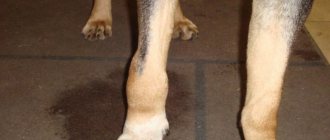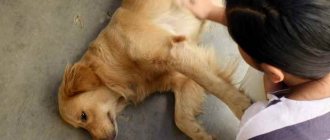Bronchitis in dogs is an inflammatory respiratory disease. The symptoms of the pathology are obvious, but similar to other problems of the respiratory system. A veterinarian must determine the disease, identify its causes and prescribe treatment. Bronchitis is dangerous because advanced inflammation can spread to the lungs, leading to pneumonia and more severe consequences.
The dog's respiratory system consists of the following sections: nose, sinuses, larynx, trachea, bronchi (bronchial tree), lungs and diaphragm. Each structure has its own irreplaceable function. Pathology in any organ can lead to a significant deterioration in the pet’s quality of life due to impaired oxygen supply to the tissues.
What is bronchitis, its types in animals
Bronchitis is the development of an inflammatory process in the mucous layer of the bronchi in a dog. The pathology is characterized by sudden bouts of coughing and nasal discharge.
The inner layer of the bronchi secretes mucus throughout life. One of its main functions is protective. Mucus helps get rid of foreign objects and also contains a lot of proteins. This composition creates a bactericidal barrier and does not allow pathogens to penetrate into the respiratory tract. With the development of bronchitis, the mucous layer becomes inflamed, the protective function is disrupted and the bronchi become susceptible to the penetration of pathogenic microorganisms. The process is accompanied by the accumulation of exudate, as a result of which the lumen of the bronchi narrows and gas exchange is greatly reduced.
By origin, the pathology is:
- Primary, when inflammation develops as an independent disease.
- Secondary, when bronchitis is a symptom or complication of the underlying disease.
According to the nature of the course, inflammation is divided into:
- Acute - lasts less than 10 days, symptoms are obvious. If a dog with this form receives inadequate treatment, bronchitis becomes chronic.
- Chronic - pathology lasts more than 10 days. The pet initially shows improvement, but then the symptoms worsen again and recur periodically.
In veterinary medicine, bronchitis is also distinguished by the type of inflammation:
- serous;
- catarrhal;
- purulent;
- putrefactive;
- fibrinous;
- hemorrhagic.
Signs of chronic bronchitis
Chronic bronchitis is a long-term inflammatory process in the bronchi. If a dog's cough does not go away within two months, it means it has become chronic. In dogs, bronchitis progresses slowly and cannot be completely cured.
The main signs of chronic bronchitis:
- prolonged cough (more than two months in a row);
- dyspnea;
- blue or pale mucous membranes;
- fainting;
- breathing with whistling, wheezing;
- fast fatiguability.
With chronic bronchitis in dogs, shortness of breath, fainting, fatigue, and more are observed.
The animal constantly coughs, with periods of remission followed by periods of deterioration. A cough with chronic inflammation of the bronchi is usually dry; during periods of exacerbation, sputum appears. Over time, your pet may develop COPD (chronic obstructive pulmonary disease).
Reasons why a dog can get sick
The following factors can lead to bronchitis in a dog:
- Pathogenic microorganisms of various natures: viral (canine distemper, parvovirus, herpes, adenovirus, influenza, parainfluenza), bacterial (mycoplasmosis, chlamydia, bordetellosis, tuberculosis), fungal.
- Entry of a foreign object into the respiratory tract.
- Violation of the pet's keeping conditions (constant high humidity, poor ventilation).
- Hypothermia (swimming in a cold body of water, long walks for pets of short-haired breeds at low temperatures).
- Inhalation of chemical or allergenic substances that irritate the mucous membranes: gases, smoke, household chemicals, pollen, dust. When exposed to such agents, eosinophilic bronchitis develops.
- Concomitant diseases of the respiratory system.
- Parasitic diseases.
- Neoplasms.
Associated causes that can trigger the development of inflammation:
- Age. If it is infectious, puppies under one year of age are more likely to get sick.
- Crowded housing of animals in nurseries or shelters.
- Almost any form of bronchitis is complicated by a bacterial infection 5-7 days after the onset of inflammation.
- Lack of vaccination.
- Breed characteristics (brachycephalic dogs, representatives of miniature breeds, as well as hunting breeds are more susceptible to the disease).
Symptoms of bronchitis in dogs
Clinical signs of bronchitis in dogs may include:
- Refusal to eat.
- General depressed state (the pet lies all the time, refuses favorite games, reluctantly agrees to go for a walk).
- Gradual exhaustion.
- Rhinitis (runny nose) develops, and the discharge may be clear, yellow, green, or brownish. The discharge can be of various types, symmetrical or one-sided, with or without odor.
- Sneezing.
- Cough (the first 3-4 are dry, then gradually replaced by wet cough).
- When breathing, wheezing is heard.
- Often the animal has an unnatural body position: the pet cannot lie down.
- Shortness of breath appears - difficulty breathing, which occurs due to a lack of oxygen metabolism. Characterized by changes in inhalation and exhalation.
- Breathing becomes abdominal type (normally it should be thoraco-abdominal).
- If bronchitis is viral in nature, the animal also experiences diarrhea (black, foul-smelling), vomiting, discharge from the eyes, and elevated body temperature.
Mortality from the disease is low when it comes to primary bronchitis. In young animals, death occurs due to the viral nature of the pathology.
Clinical picture and diagnosis
Bronchitis in dogs rarely leads to major changes in clinical condition. In the acute form, slight depression is noted, the temperature may be slightly increased - a pronounced temperature reaction indicates a primary infectious cause. Chronic bronchitis is accompanied by periods of slight deterioration (coughing attacks) and normal conditions. Coughing attacks in chronic bronchitis are usually observed in the morning, after a night of immobility.
- cough is frequent, painful and dry at the beginning of the disease;
- after a few days the cough changes to wet and dull;
- the type of discharge from the nasal passages depends on the type of inflammation;
- the discharge is thick and insignificant in the first 2-3 days, then it becomes liquid;
- by listening to the lungs, vesicular breathing and wheezing are determined;
- percussion can determine pain; dullness of sound is detected only with significant exudation.
A severe course is characteristic of infectious forms. In dogs, severe depression is noted, the temperature rises to 40 degrees, and a febrile process occurs. There is no appetite, exhaustion is inherent, and signs of damage to the digestive system often appear.
The prognosis for acute bronchitis is usually favorable if the dog is treated promptly. Chronic inflammation often leads to complications. Dogs develop atelectasis, pulmonary emphysema. To make a diagnosis, it is necessary to operate on the data of the anamnesis and clinical picture. Instrumental and laboratory tests are necessary for differential diagnosis - the picture of bronchitis is characteristic of many dangerous infectious and parasitic pathologies that require special treatment.
After coughing, the dog begins to vomit; many owners mistake this for vomiting.
In dogs, chronic bronchitis should be differentiated from heart failure. Here, an important diagnostic point is auscultation of the heart. When listening, you can identify a “cat purring”, which is a sign of damage to the heart valves. But if there is no tachycardia, then congestive heart failure should be excluded. Electrocardiography also reveals sinus arrhythmia.
Study of the secretion of the upper respiratory tract is necessary to identify the pathogen and the correct selection of specific treatment. Cultures are done on nutrient media in Petri dishes with antibiotic titration. Microscopy of the mucus is also necessary to determine the presence of helminth eggs in it.
In some cases, bronchoscopy may be useful. The endoscopic method is used to determine swelling and erosion on the mucous membrane, and accumulation of exudate. In complicated cases, collapse and spasm of the bronchi are detected.
How to determine bronchitis in a dog?
Only a veterinarian can make an accurate diagnosis and establish the cause of inflammation. To do this, the doctor conducts a general examination and a number of studies:
- First of all, the veterinarian collects information about the dog: how long has it been sick, whether vaccinations have been carried out, what other symptoms there are, what kind of food the pet receives.
- Breathing assessment: frequency, depth, rhythm, presence of shortness of breath.
- Establishing the type of breathing: thoracic, abdominal, thoraco-abdominal.
- Presence of cough (without this symptom a latent chronic form of bronchitis is possible).
- Auscultation (will reveal wheezing, cardiac dysfunction).
- Thermometry.
- Blood tests (general clinical and biochemical).
- X-ray (the image evaluates the bronchial pattern, position of the lungs, and the presence of tumors).
- If necessary, bronchoalveolar lavage and bronchoscopy are performed to take swabs.
- Diagnosis of viral diseases: PCR, ELISA, serological studies.
Diagnosis of bronchitis
To make a correct diagnosis, the doctor will need to collect as much information as possible about the dog and conduct laboratory and x-ray examinations.
What your veterinarian may ask you:
- conditions for keeping the dog;
- features of her feeding;
- availability of vaccinations;
- how long ago the symptoms of the disease appeared;
- whether the dog had contact with sick animals.
To make a diagnosis, the veterinarian examines the dog's airways.
During the examination, the doctor examines the upper respiratory tract of the animal, listens to the trachea, lungs, and bronchi. He may take a swab from the larynx. In some cases, examination of the esophagus, pharynx, trachea, and bronchi using an endoscope may be required.
When your pet coughs, you need to exclude infectious diseases (rinotracheitis, parainfluenza, plague, adenovirus) and parasitic diseases (ascariasis, coccidiosis). A general blood test will be required, as well as an infection test. An X-ray examination will help clarify the diagnosis.
Treatment of bronchitis in dogs
Treatment of bronchitis in dogs can be carried out at home, strictly following all doctor’s prescriptions. In a familiar environment, the animal does not experience stress, which speeds up the healing process. The pet is kept in a warm room and goes out for walks for a short time. Inpatient treatment is carried out for severe secondary bronchitis. In the clinic, doctors monitor the dog’s condition, blood counts and breathing, and restore fluid loss.
The elevated temperature is not reduced until a certain point (if possible to 40.1 - 40.6 ° C). The body develops this defense mechanism to fight infection.
In acute cases, symptomatic therapy is carried out. The duration of treatment depends on the severity of the process and the animal’s immunity. If there is nasal discharge, it should be carefully removed as it accumulates.
Antibiotics are indicated for obvious symptoms of bronchitis in a dog of a bacterial nature (lethargy, refusal to eat, nasal discharge). If, after using the first and second choice drugs, the animal does not improve, a BAC culture is performed. Otherwise, bacteria develop resistance to drugs, bronchitis becomes chronic, and it will be more difficult to cure this form in a dog. It is important to find the exact cause of the disease and eliminate it.
If necessary, the pet is prescribed inhalations with saline solution 3-4 times a day. This procedure facilitates the separation of sputum and makes it easier for the animal to breathe. Small dogs are easier to manipulate than large dogs. It is enough to put them in a carrier and throw a blanket on top. Then the tube from the nebulizer is brought to the grille and the pet is allowed to breathe in the vapor. For large animals, the device is placed directly on the nose.
Examples of medications that are used to treat bronchitis in dogs:
| Nature of action of the drug | Prescribed funds |
| Antibacterial drugs |
|
| Expectorants | Bromhexine, ACC, Ambroxol, they facilitate sputum production |
| Immunomodulators | Roncoleukin, Ribotan, Imunofan (for viral nature of inflammation) |
| Solutions for thinning sputum | Saline solution, mineral water (used in the form of inhalations) |
Expert opinion
Kuzmenko Olga Olegovna
Information about the expert
Ask a Question
In case of an allergic nature, antihistamines are prescribed during the period of exacerbation of the condition. The main measure is to prevent the animal from coming into contact with the irritating substance.
Diagnosis and treatment
To make a diagnosis, the veterinarian will need to carry out a number of diagnostic measures: examination of the respiratory tract, listening to the trachea, lungs, bronchi, blood tests, testing for infections, and x-ray examination.
To get a complete picture and exclude other possible diseases, a specialist must find out the conditions under which the animal is kept, its nutritional habits, vaccinations, and contacts with sick animals.
Treatment of bronchitis in dogs is carried out at home. First of all, the patient is provided with complete rest, warmth, and the necessary adjustments to the diet (food should be warm and liquid).
If the air in the room is too dry, it needs to be humidified. You shouldn’t give up walking (unless your doctor prohibits it), but it is advisable to shorten the walking time and insulate the dog’s chest with a vest or regular scarf.
The doctor prescribes medications for treatment based on the individual characteristics of the dog, its age, and chronic diseases. You should not self-medicate, as this can lead to serious health problems.
For bacterial bronchitis, the animal is prescribed drugs that stimulate the immune system (Catozal, Glycopin). It is mandatory to take broad-spectrum antibiotics (Streptomycin, Penicillin).
If these drugs are ineffective, a course of intramuscular injections of Tetracycline in combination with kanamycin sulfate and Levomycetin is prescribed. In some cases, your doctor may prescribe Enroxil, an antibiotic used for upper respiratory tract infections.
Symptomatic treatment of tracheobronchitis in dogs involves taking antitussive drugs. For a wet cough, Bromhexine, ACC, Broncholitin (mucolytic agents) are prescribed. It is advisable to use herbal expectorants or tinctures of coltsfoot and thermopsis. Therapeutic tapping will help eliminate stagnation of mucus in the respiratory organs.
To relieve bronchial spasms, it is recommended to take Ephedrine, Izadrina, Zufillin.
If bronchitis in dogs, the symptoms and treatment of which we are considering, is caused by allergies, the use of antihistamines and glucocorticoids is necessary.
For a runny nose, drops with anti-inflammatory and antibacterial effects Anandin or Maxidin are used.
To increase immunity, effectively discharge sputum, and warm up the respiratory tract, the dog is prescribed auxiliary therapy - UHF, Sollux, physiotherapy, infrauge.
How to feed your pet when sick
During illness, it is important for the animal to stimulate its appetite. If the nose is clogged, the dog cannot smell, which reduces the quality of feeding. The pet is offered wet food; if necessary, it is heated (so that the smell is more pronounced). If there is no appetite, the animal is treated to its favorite delicacies (provided that these are not fried or smoked foods).
If the desire to eat does not arise within 3 days, the pet is force-fed. Liquid, softened food is offered by hand or introduced into the mouth from a syringe. If you abstain from food for a longer period of time in a veterinary clinic, the procedure is carried out through a tube, or parenteral nutrition is used (solutions, amino acids and the necessary elements to maintain vital functions are administered intravenously).
During the recovery period, the dog's diet should contain easily digestible ingredients. The feed is slightly warmed up before feeding. Vitamin supplements are administered in consultation with the doctor.
Types of bronchitis
It is conventionally accepted to divide bronchitis into primary and secondary. The first type develops against the background of a cold, hypothermia, or inhalation of irritant substances, the second is a consequence of another disease, that is, a complication. Inflammation existing in the tonsils and trachea, in the absence of adequate treatment, can “sink” lower and penetrate into the bronchi.
Often, secondary bronchitis develops against the background of damage to the respiratory organs by parasites, progressive allergies, plague, compression of the respiratory organs by enlarged lymph nodes or a tumor.
Untreated, advanced bronchitis takes on a chronic form, which is much more difficult to cope with. Chronic inflammation leads to disruption of gas exchange in the bronchi. The body will experience a lack of oxygen, which significantly increases the chances of developing pathologies of the cardiovascular and nervous systems.
It is impossible to independently determine the type of bronchitis, therefore, as soon as your pet starts coughing, immediately take him to a veterinary clinic, where he will be examined and appropriate therapy will be prescribed.
Prevention measures
- Conduct annual routine vaccination against viral infections.
- Give anti-helminth medications once every 3-4 months.
- In the warm season, carry out treatment against ectoparasites in a timely manner.
- Balanced diet. Selecting good quality commercial feed or selecting ingredients to create a complete homemade diet.
- Provide optimal conditions for keeping the pet (monitor the level of humidity in the room, temperature conditions).
- Avoid contact of the dog with irritating and harmful gases and chemicals.
- In the cold season, representatives of smooth-haired breeds wear special insulated suits for walks.
- When kept in a shelter or nursery, sick and newly arrived animals are isolated for the entire period of treatment or for the duration of quarantine. The premises are periodically disinfected with special solutions.
- When kept in enclosures in winter, food and drinking water are heated.
Bronchitis in dogs can develop as an independent disease or be a concomitant symptom of serious pathologies. In any case, the pet’s quality of life decreases due to disruption of gas exchange processes in organs and tissues. After a series of necessary studies, the veterinarian prescribes treatment, which must be carried out in full to prevent the pathology from becoming chronic.
Feeding a dog when sick
When your dog is sick, it is best to avoid dry food.
During the period of illness, it is advisable to include easily digestible warm food in the dog’s diet. Porridge (rice, oatmeal), boiled and pureed meat (chicken, beef), heated dairy products (kefir, milk) are suitable. Raw eggs can be given one at a time no more than three times a day. It is better to refuse dry food until the dog’s cough goes away.
A sick dog should have a bowl of water at room temperature. You can add to the water decoctions of herbs with an expectorant effect (anise, dill, pine buds, oregano, wild rosemary) or anti-inflammatory (chamomile, sage, eucalyptus, string, yarrow). Rice water is also suitable for drinking.
Respiratory diseases occur due to a deficiency of vitamins A, E and C, so it is worth introducing foods rich in these vitamins into the diet, or purchasing a vitamin-mineral complex for animals.
If your pet coughs, this is a reason to immediately show it to a veterinarian. If treatment is started promptly, your dog's bronchitis will go away within one or two weeks. Otherwise, a chronic form of the disease may develop, and this is dangerous for the cardiovascular and nervous system of the animal.
Among colds in pets, bronchitis is the most common ailment affecting the upper respiratory tract. The pathology is inflammatory in nature and affects the submucosal tissues and mucous membrane of large and small bronchi. Bronchitis in pets should never be neglected, since the disease is dangerous due to impaired gas exchange and the development of pneumonia and emphysema.











